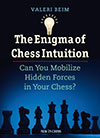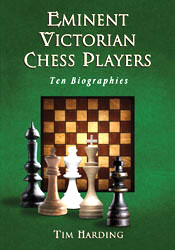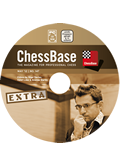Positional
Chess Sacrifices by Mihai Suba
2012
Quality Chess
373 pages
Price €25,99
ISBN 978-3-906552-86-2
The Romanian grandmaster Mihai Suba digs with this book into the world
of chess sacrifices, specially positional chess sacrifices as we for
example
can see in the following game from the great Garry Kasparov:
Kasparov,Garry - Anand,Viswanathan Riga Tal Memorial Riga (4), 1995
1.e4 e5 2.Nf3 Nc6 3.Bc4 Bc5 4.b4 Bxb4 5.c3 Be7 6.d4 Na5 7.Be2 exd4
8.Qxd4 Nf6 9.e5 Nc6 10.Qh4 Nd5 11.Qg3 g6 12.0-0 Nb6 13.c4 d6
14.Rd1 Nd7 15.Bh6!
Suba writes:On move 11 we saw Anand rejecting a promising exchange
sacrifice,which would have enabled him to maintain the balance
.A few moves later,Kasparov seizes an opportunity to make a
positional sacrifice of his own.Already one pawn down from the
opening ,he
doubles his material investment in order to keep the enemy king pinned
down in the centre.
Suba has included hundreds of games and game clippings in this book,and
going throw these games will help you develop a natural feeling for
sacrifices.
Spielmann was for a long time one of the greatest practitioners of the
real sacrifice, but Suba does not like his definition of a positional
sacrifice.
Included are various Fischer games as Fischer,Robert James -
Addison,William [B01]
Interzonal Palma de Mallorca (3), 11.11.1970
1.e4 d5 2.exd5 Qxd5 3.Nc3 Qd8 4.d4 Nf6 5.Bc4 Bf5 6.Qf3 Qc8 7.Bg5 Bxc2
8.Rc1 Bg6 9.Nge2 Nbd7 10.0-0 e6 11.Bxf6 gxf6
12.d5 e5 13.Bb5 Be7 14.Ng3 a6 15.Bd3 Qd8 16.h4 h5 17.Bf5 Nb6 18.Nce4
Nxd5 19.Rfd1 c6 20.Nc3 Qb6 21.Rxd5 cxd5 22.Nxd5 Qxb2
23.Rb1 Qxa2 24.Rxb7 1-0,Suba writes, black’s problems in the
above game were not the result of a single blunder, but rather an
accumulation
of small mistakes.The slightly unfortunate combination of 3….Qd8 and
5…Bf5?! Gave white an early intiative,and the subsequent decision to
grab a pawn with 7…Bxc2 left black some way behind in
development.Even then his position was far from helpless,as just as we
have seen
in several other games,he could have kept a playable position by
making a material sacrifice of his own with 11…Nxf6!Once
He missed that opportunity, Fischer developed a horrible clamp on the
light squares and black had practically no chance to save himself.
All sacrifices are readable divided in to several openings sections as
the Open Games and Flank Openings but there are also some suberb.
Sections on Minor Piece and End Game sacrifices
Conclusion: One of those Quality Chess
super reads!
Das Alterman Gambit-Handbuch - Gambits mit
Schwarz 2 by Boris Alterman
2012
Quality Chess
384 pages
Price €21,99
ISBN 978-3-942383
Grandmaster Boris Alterman offers the black side of the board the
following gambits:
Marshall Gambit with the moves: 1.e4 e5 2.Nf3 Nc6 3.Bb5 a6 4.Ba4 Nf6
5.0-0 Be7 6.Re1 b5 7.Bb3 0-0 8.c3 d5 9.exd5 Nxd5
10.Nxe5 Nxe5 11.Rxe5 Nf6 and 11…Bb7?!.
Hector Gambit:
1.e4 e5 2.Nf3 Nc6 3.Bb5 a6 4.Bxc6 dxc6 5.0-0 Bg4 6.h3 Bh5 7.g4 Bg6
8.Nxe5 f6 or 8…Bd6,
Traxler: 1.e4 e5 2.Nf3 Nc6 3.Bc4 Nf6 4.Ng5 Bc5,The Frankenstein
Dracula:
1.e4 e5 2.Nc3 Nf6 3.Bc4 Nxe4 4.Qh5 Nd6 5.Bb3 Nc6 6.Nb5 g6 7.Qf3 f5
8.Qd5 Qf6 9.Nxc7+ Kd8 10.Nxa8 b6,
The Falkbeer Gambit:1.e4 e5 2.f4 d5 3.exd5 e4,Froms Gambit 1.f4 e5,and
various lines as the Two Knights Defence.
Again Alterman is good for some exciting lines but as Harding and Wade
wrote back in 1974,present day theorist consider 11…Nf6 not quite
adequate, but it is seen occasionally.
But if you ask me it could me a dangerous surprice weapon!
Conclusion: Overloaded with smashing
lines!
 The Enigma of Chess
Intuition by Valeri Beim
The Enigma of Chess
Intuition by Valeri Beim
2012
New in Chess
http://www.newinchess.com/
268 pages
Price € 24,95
ISBN:
978-90-5691-379-3
Grandmaster Valeri Beim covers in this lovely produced New in
Chess book, the difficult subject of chess intuition.
Some players as Morphy and Fischer had a unique talent for it but as
Beim explains in this book,it can be learned.
Unfortunately your chess intuition gets weaker as you grow older, but
on the other hand what is old?
But first some moves and words from Beim on the famous Fischer – Geller
Monte Carlo game from 1967:
1.e4 c5 2.Nf3 d6 3.d4 cxd4 4.Nxd4 Nf6 5.Nc3 a6 6.Bg5 e6 7.f4 Qb6 8.Qd2
Qxb2 9.Rb1 Qa3 10.f5 Nc6 11.fxe6 fxe6
12.Nxc6 bxc6 13.e5 Nd5 At this time,the continuation 13…dxe5 was
considered obligatory.It is highly likely that
Geller took Fischer away from known lines,but it is also quite possible
that the latter was prepared for such a turn of events.
But there is something else interesting: the whole line was one of
Fischer’s own favourites for black!
One the other hand,Geller had only played the black side of the line
once before,and against a not very serious opponent,and
afterwards,he only played it three times more,also against opponents
who where greatly below his class.Consequently,choosing
it here against Fischer clearly owed a great deal to psychological
considerations.
All together this game well analysed with nearly five pages of
instructive text!
Nerves have a impact on the quality of the intuitive decisions or even
on the ability to make them at all.
Interesting are the words from Beim on Morphy:It is widely known that
this poor Amerikan chess genius suffered for a large part of his fairly
short life from serious psychiatric problems,and was in general an
impressionable person.
It would appear {although I am not specialist and so cannot speak with
categorical certainly about this} that a person with such
characteristics
ought to be vulnerable,but from the testimony of his contemporaries,
Morphy was exceptionally correct at the board,confident in himself and
always calm.
But could it be part of the reason why one of the greatest chess
geniuses of all time gave up practical play so early that he found it
increasingly
difficult to maintain this calm in the face of events at the board?
Included in this book is the game position Anderssen – Morphy Paris
1858 and Bird – Morphy London 1858.
For the interested reader try to lay hands on Beim his book on
Morphy:Paul Morphy A Modern Perspective.
The whole material is packed in 3 readable chapters:First
Explorations,Successful use of intuitions and the elements of chess
intuition.
Conclusion: A superb. learning book!

1001 chess exercises by Franco Masetti & Roberto
Messa
2012
New in Chess
http://www.newinchess.com/
144 pages
Price € 15,95
ISBN:
978-90-5691-397-7
There is probably no better way to learn tactics than throw exercises,
and this book from Masetti and Messa is overloaded with all kind of
mats.
It starts all simple with mats in one but slowly moves on to mate in 4.
But there is more as double attacks, pins and so on.
The references to the games do not impress me but all together we have
here a very good learning book!
Conclusion: There is no better way to
sharpen your tactical skills!
 Eminent Victorian
Chess Players by Tim Harding
2012
McFarland &
Company,Inc.,Publishers Box 611
Eminent Victorian
Chess Players by Tim Harding
2012
McFarland &
Company,Inc.,Publishers Box 611
Jefferson,North Carolina 28640.
http://www.mcfarlandpub.com
266 pages
Price $49.95
ISBN 978-0-7864-6568-2
The well known chess researcher, author and chess master Tim
Harding comes with a major study, on the British chess life in the
nineteenth century, where Harding digs in the British chess history
focusing on some of its leading players as William Davies Evans,Howard
Staunton, John Jacob Löwenthal,Henry Edward Bird, Arthur Bolland
Skipworth,William Steinitz,Joseph Henry Blacknurne,Johannes
Zukertort,Amus Burn and Isidor Arthur Gunsberg.
Tim Harding does not offer in this book a complete biography of the
players but concentrates more on the most interesting of the above ten.
Most of all know that William Davies Evans 1790 – 1872 was inventor of
the Evans Gambit,
and his idea to play 4.b4 was hailed as a gift from the gods.
George Walker wrote in 1845:”Captain Evans’s Gambit….was the greatest
chess discovery of the present age”.
But the crucial details of his life and work have long been obscured by
lack of sources but Harding has managed to fit the missing puzzle
pieces together!
Evans was the captain of a packet boat in the postal service, plying
between Wales and Ireland.
Harding writes;In good weather,Evan’s tasks on board would have become
less onerous,not beingrequired constantly to attend to sails.
He now had opportunity to study chess.Evans himself gave an of the
gambit’s origin as follows: About the year 1824,being then in command
of a Government steamer, the passages between Milford Haven and
Waterford were Waterford were favourable to the study of the game of
chess,and this time he invented the gambit which bears his name.The
idea occurred to him while studying a narration of the Qiuoco Piano in
Sarratt’s treatise on the game of chess.
Included throw this book are 61 photo’s and illustrations, appendices,
notes, bibliography, indexes and over 160 games,as the following beauty
from Evans: Evans,William - McDonnell,Alexander [C52]
Londen, 1824,1.e4 e5 2.Nf3 Nc6 3.Bc4 Bc5 4.0-0 d6 5.b4 Bxb4 6.c3 Ba5
7.d4 Bg4 8.Qb3 Qd7 9.Ng5 Nd8 10.dxe5 dxe5 11.Ba3 Nh6
12.f3 Bb6+ 13.Kh1 Bh5 14.Rd1 Qc8 15.Rxd8+ Qxd8 16.Nxf7 Qh4 17.Qb5+ c6
18.Qxe5+ Kd7 19.Qe6+ Kc7 20.Bd6# 1-0.
This game is well analysed by Harding,who is by the way a expert on the
Evans gambit!
Pleasantly enough Harding has included in this book all the games that
Captain Evans had ever played.
Harding writes:Since the number of known games by Captain Davies Evans
is relatively small few than 50 they
are all collected here,with source information but minimal notes.
Evans peak Rating was 2314 in 1843 but Evans played no formal matches
or tournaments so no firm rating could be calculated.
Steinitz had a peak rating of 2802,Zukertort 2677,Staunton 2632 above
2600 from 1844 to 1846,Skipworth 2304,Löwenthal
2571,Gunsberg 2629,Burn 2596,Bird 2550 and at last the chess legend
Blackburne had a peak rating from 2635 and was above
the 2600 from 1873 to 1887.
Josef Blackburne was the leading English – born chess master of the
Victorian era,and for many years one of the
world’s top tournament players.In an extraordinary long career
stretching from the early 1860s to 1914.
As Harding explains no real biography of Blackburne has ever
appeared,and even an attempt to collect his complete games would be a
massive
undertaking.The standard book about hime,Mr.Blackburne’s Games
at Chess appeared in 1899,and does not cover the last 15 years of his
playing career.
Harding considers Blackburne as a grandmaster after Vienna 1873,where
the tornament editors awarded him the sobriquet “the black Death”.
Blackburne was a player of the classic style,who mostly opened 1.e4.
I would like to end with a game from Blackburne against the great Aaron
Nimzowitsch:
Blackburne,Joseph Henry - Nimzowitsch,Aaron [A00]
St Petersburg preliminary St Petersburg (8), 02.05.1914
1.e3 d6 2.f4 e5 3.fxe5 dxe5 4.Nc3 Bd6 5.e4 Be6 6.Nf3 f6 7.d3 Ne7 8.Be3
c5 9.Qd2 Nbc6 10.Be2 Nd4 11.0-0 0-0 12.Nd1 Nec6
13.c3 Nxe2+ 14.Qxe2 Re8 15.Nh4 Bf8 16.Nf5 Kh8 17.g4 Qd7 18.Nf2 a5 19.a3
b5 20.Rad1 Rab8 21.Rd2 b4 22.axb4 axb4
23.c4 Ra8 24.Qf3 Ra2 25.g5 g6 26.Ng4 gxf5 27.Nxf6 Nd4 28.Qf2 Qc6
29.Nxe8 Qxe8 30.Bxd4 exd4 31.exf5 Bd7 32
Re1 Qf7 33.Qh4 Ra8 34.Rf2 Bc6 35.Qg4 Re8 36.Rxe8 Qxe8 37.Re2 Qd7 38.Re6
Ba8 39.g6 hxg6 40.Rxg6 Qh7 41.Qg3 Qh5 42.Rg4 1-0
Conclusion: Certainly one of the most interesting chess books of the
last 25
years!
 1.Nf3 - A variable
repertoire for white by Lubomir Ftacnik
2012
1.Nf3 - A variable
repertoire for white by Lubomir Ftacnik
2012
http://www.chessbase.com
E-Mail
info@chessbase.com
Euro 27,90
Pentium-Processor at 300 Mhz or higher, 64 MB RAM, Windows XP, Windows
Vista, Windows 7, DVD drive, mouse, soundcard.
The well known openings crack grandmaster Lubomir Ftacnik digs in the
world of the move 1.Nf3 and offers the user of this DVD
a reliable repertoire based on the lines of the Nimzo –
Indian,English,Dutch and more.
The 18 video files are intensive and you need around 4.5 hours of your
time to play throw it.
Ftacnik is not shy to play the moves d4 or e4 as we can see in the
following game:
Psakhis,Lev (2605) - Shneider,Aleksandr (2535) [A55]
Tilburg rapid20 Tilburg (1), 1994
1.Nf3 Nf6 2.c4 d6 3.d4 Nbd7 4.Nc3 e5 5.e4 Be7 6.Be2 0-0 7.0-0 c6 8.Be3
a5 9.d5 Qc7 10.Nd2 Nc5 11.a3 Bd7
12.b4 Na6 13.Qb3 axb4 14.axb4 c5 15.b5 Nb4 16.h3 Ra5 17.Ra4 Rfa8
18.Rfa1 Bd8 19.R1a3 h6 20.Na2 Rxa4
21.Rxa4 Rxa4 22.Qxa4 Nxa2 23.Qxa2 Qa5 24.Qxa5 Bxa5 25.Bd3 Nh5 26.h4 Nf4
27.Bf1 Ng6 28.g3 Ne7
29.Nb3 Bd8 30.Bd2 b6 31.Kh2 Bg4 32.Kg2 Bd1 33.Nc1 f5 34.exf5 Nxf5
35.Be2 Ba4 36.Bd3 Nd4 37.Ne2 Nc2
38.Nc3 Bb3 39.Ne4 Be7 40.Bc3 Nb4 41.Nd2 Bd1 42.Bf1 Nc2 43.Ne4 Nd4
44.Bxd4 exd4 45.Bd3 g5 46.hxg5 hxg5
47.f3 g4 48.f4 Kg7 49.Nf2 Bf3+ 50.Kf1 Kf6 51.Ne4+ Kg7 52.Nf2 Kh6 53.Be4
Kh5 54.Ke1 d3 55.Bxd3 Bf6 56.Be2 Bd4
57.Kf1 Kg6 58.Bxf3 gxf3 59.Ne4 Kf5 60.Nxd6+ Kg4 1-0
Included are lines as Hedhehog and Catalines lines with out the move d4.
Conclusion: Ftacnik offers the user a
life time repertoire line!
 Beating the Berlin
Defence by Alexei Shirov
2012
Beating the Berlin
Defence by Alexei Shirov
2012
http://www.chessbase.com
E-Mail
info@chessbase.com
Euro 29,90
Pentium-Processor at 300 Mhz or higher, 64 MB RAM, Windows XP, Windows
Vista, Windows 7, DVD drive, mouse, soundcard.
Last month we had the latest repertoire work from Lysyj and Ovetchkin
on the Berlin Defence,but this latest chess DVD from the chess
genius Alexei Shirov shows us how to beat it!
Just take 3 hours and 49 minutes of your time and you will be able to
tackle the Berlin Wall!
All material is well packed with instructive explanations into 11 heavy
loaded video files.
One of the latest files comes from the game Shirov,A (2705) -
Naiditsch,A (2712) [C67]
TCh-ESP CECLUB Div Honor 2011 Melilla ESP (3), 23.11.2011
1.e4 e5 2.Nf3 Nc6 3.Bb5 Nf6 4.0-0 Nxe4 5.d4 Nd6 6.Bxc6 dxc6 7.dxe5 Nf5
8.Qxd8+ Kxd8 9.Nc3 h6 10.h3 Bd7 11.b3 c5
12.Rd1 Kc8 13.Nd5 a5 14.a4 Ne7 15.c4 Bf5 16.Ra2 Ra6 17.Nc3 g5 18.Rad2
Nc6 19.Nd5 Bg7 20.Bb2 Be4 21.Re2 Bxf3
22.gxf3 Re8 23.Kf1 Nd4 24.Bxd4 cxd4 25.Rxd4 c6 26.Ne3 Bxe5 27.Re4 Re6
28.Nf5 f6 29.Nxh6 Rb6 30.R2e3 Rd6 31.c5 1-0.
Lysyj and Ovetchkin concentrate more on the line with 9…Ke8.
Shirov covers on this DVD the following game: Shirov,Alexei (2713) -
Steingrimsson,Hedinn (2562) [C67]
Bundesliga 1112 Germany (7.1), 11.12.2011
1.e4 e5 2.Nf3 Nc6 3.Bb5 Nf6 4.0-0 Nxe4 5.d4 Nd6 6.Bxc6 dxc6 7.dxe5 Nf5
8.Qxd8+ Kxd8 9.Nc3 Ke8 10.h3 Be7
11.g4 Nh4 12.Nxh4 Bxh4 13.Ne2 h5 14.f3 b6 15.Nf4 Ba6 16.Rd1 hxg4
17.fxg4 Ke7 18.b3 Bb7 19.e6 Rhd8 20.Rf1 Bf6
21.exf7 c5 22.f8Q+ Rxf8 23.Ng6+ Ke8 24.Bb2 Bd4+ 25.Bxd4 Rxf1+ 26.Rxf1
cxd4 27.Rf8+ Kd7 28.Rf4 Re8 29.Rxd4+ Kc8
30.Rd2 a5 31.Kf2 Re6 32.Nh4 a4 33.bxa4 Re4 34.Nf5 g6 35.Nd4 c5
36.Nb5 Rxa4 37.Rd6 g5 38.Ke3 Rxa2 39.Rh6 Bg2
40.c4 Kd7 41.Nc3 Rc2 42.Na4 Ke8 43.Nxb6 Bxh3 44.Re6+ Kf7 45.Re4 Bf1
46.Nd7 Re2+ 47.Kf3 Rxe4 48.Kxe4 Ke7 ½-½.
Shirov explains I thought that I was going to win, but I am not ashamed
about this game.
The Berlin Defence is more based on understanding than memorizing and
that makes it the perfect weapon!
Conclusion: Superb!







